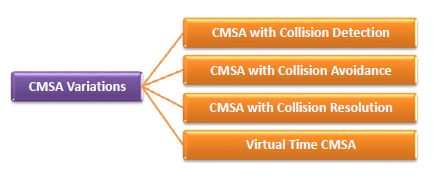
 Data Structure
Data Structure Networking
Networking RDBMS
RDBMS Operating System
Operating System Java
Java MS Excel
MS Excel iOS
iOS HTML
HTML CSS
CSS Android
Android Python
Python C Programming
C Programming C++
C++ C#
C# MongoDB
MongoDB MySQL
MySQL Javascript
Javascript PHP
PHP
- Selected Reading
- UPSC IAS Exams Notes
- Developer's Best Practices
- Questions and Answers
- Effective Resume Writing
- HR Interview Questions
- Computer Glossary
- Who is Who
What is Carrier Sense Multiple Access (CSMA)?
Carrier Sense Multiple Access (CSMA) is a network protocol for carriertransmission that operates in the Medium Access Control (MAC) layer. It senses or listens whether the shared channel for transmission is busy or not, and transmits if the channel is not busy. Using CMSA protocols, more than one users or nodes send and receive data through a shared medium that may be a single cable or optical fiber connecting multiple nodes, or a portion of the wireless spectrum.
Working Principle
When a station has frames to transmit, it attempts to detect presence of the carrier signal from the other nodes connected to the shared channel. If a carrier signal is detected, it implies that a transmission is in progress. The station waits till the ongoing transmission executes to completion, and then initiates its own transmission. Generally, transmissions by the node are received by all other nodes connected to the channel.
Since, the nodes detect for a transmission before sending their own frames,collision of frames is reduced. However, if two nodes detect an idle channel at the same time, they may simultaneously initiate transmission. This would cause the frames to garble resulting in a collision.
CMSA Access Modes
The versions of CMSA access modes are−

Variations of CMSA protocol
There may be further additions to the basic CMSA protocols. This results is the various protocols as follows−


